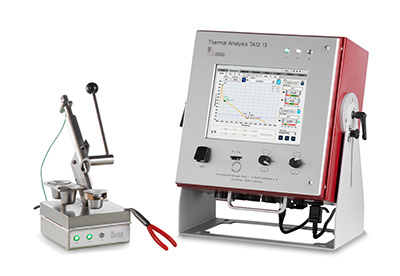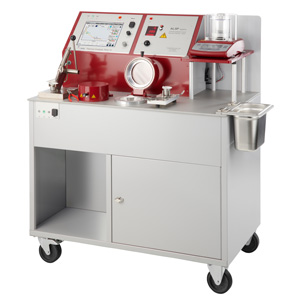Thermal Analysis
In order to achieve specific mechanical properties (e.g. strength and ductility) on the casting or to optimise the casting properties, the control of the melt by means of thermal analysis is essential. In this way, conclusions can be drawn easily and quickly about the expected mechanical properties and allow timely intervention, such as the controlled addition of grain refining and modification preparations to the melt.
Thermal Analysis TA 12.13, consisting of a monitoring system and a sensor-stand with thermocouple, is used to monitor the quality of typical AI cast alloys with a silicon content between approx. 5% and 13%, as well as various established special alloys*, as AlZn10Si8Mg, AlMg5, AlCu4Ti.
*customised alloys on request
Various factors have an influence on the course of the temperature and thus on the quality of the melt. These include:
- Ratio of the addition of ingot material to recycled material and scrap
- Tolerance ranges of the chemical elements per Al alloy
- Burn-off of alloying elements, such as Mg and Na
- Addition and quantity of modifying agents, such as Sr or Na
- Addition and quantity of grain refining agents, such as TiB
- Duration of the standing time after the melt treatment
During the solidification of an Al melt sample in a durable stainless steel crucible, the cooling curve is recorded using a permanent thermocouple and visually displayed in real time with all holding and turning points. A stainless steel protection tube protects the permanent thermocouple (NiCr-Ni - class 1) from freezing in the sample.
The grain refinement (GR) and the modification (M) are decisive key figures for the microstructure and the mechanical properties to be expected. While the grain refinement describes the grain size, the modification represents the homogeneous distribution of the silicon in the microstructure. The reusability of the measuring components (crucible and thermocouple) allows objective comparability of the samples. Furthermore, the addition of TiB, Sr and Na can actively influence the quality properties of the melt. The goal of reducing rejects and thus saving resources is made possible by continuous melt monitoring with TA 12.13. The associated MeltBoard PC software allows the tabular and graphic display of individual measurements and measurement series. The standardised comparability, evaluation and archiving of all measurement results is ensured, as is the use for internal and external reporting. The pre-configured standard report can be customised and extended with your own functionality.
Differentiation to analytical micrograph and & spectral analysis
The evaluation of a melt by means of the Thermal Analysis TA 12.13 regarding grain refinement and modification, which determines the effectiveness of the elements present as well as those added (TiB and Sr/Na), can only be confirmed by a microsection sample. Compared to thermal analysis, the performance of a microsection test is very time consuming. This makes the microsection sample almost impossible to use as a quick decision criterion on the further procedure in the daily production process. Therefore, the microsection is only a retrospective comparison to the TA. A spectrometer is a quantitative observation of the elements present and provides only little information about their influence and effectiveness in terms of grain refinement and modification.



